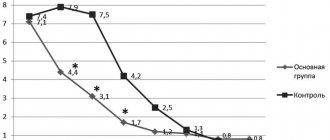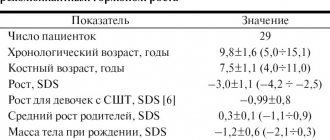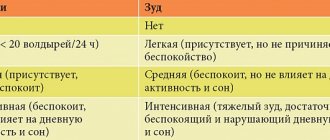Solu-Cortef lyophilisate 100 mg 2-capacity bottle with solvent
1. Endocrine diseases. • Primary or secondary adrenal insufficiency (the drugs of choice are hydrocortisone or cortisone; if necessary, their synthetic analogues can be used in combination with mineralocorticoids, especially in pediatric practice). • Acute adrenal insufficiency (drugs of choice are hydrocortisone or cortisone; concomitant use of mineralocorticoids may be necessary). As symptomatic therapy: • In the preoperative period, in case of severe injury or serious illness, in patients with established or suspected adrenal insufficiency. • Shock that does not respond to conventional treatment when adrenal insufficiency is possible. • Congenital adrenal hyperplasia. • Subacute thyroiditis. • Hypercalcemia due to cancer. 2. Rheumatic diseases (as an additional therapy for a short time to relieve an acute condition or during an exacerbation). • Acute and subacute bursitis. • Acute gouty arthritis. • Acute nonspecific tenosynovitis. • Ankylosing spondylitis. • Epicondylitis. • Post-traumatic osteoarthritis. • Psoriatic arthritis. • Rheumatoid arthritis, including juvenile rheumatoid arthritis (low dose maintenance therapy may be required in selected cases). • Synovitis in osteoarthritis. 3. Systemic connective tissue diseases (during exacerbation or in some cases as maintenance therapy). • Acute rheumatic carditis. • Systemic dermatomyositis (polymyositis). • Systemic lupus erythematosus. 4. Skin diseases. • Dermatitis bullosa herpetiformis. • Exfoliative dermatitis. • Mycosis fungoides. • Pemphigus. • Malignant exudative erythema (Stevens-Johnson syndrome). • Severe form of psoriasis. • Severe form of seborrheic dermatitis. 5. Allergic conditions (in the case of severe or disabling conditions for which conventional therapy is ineffective). • Acute non-infectious laryngeal edema. • Atopic dermatitis. • Asthmatic status. • Contact dermatitis. • Hypersensitivity reactions to drugs. • Seasonal or year-round allergic rhinitis. • Serum sickness. • Post-transfusion reactions such as urticaria. 6. Eye diseases (severe acute and chronic allergic and inflammatory processes with eye damage). • Allergic conjunctivitis. • Allergic marginal corneal ulcers. • Inflammation of the anterior segment. • Chorioretinitis. • Diffuse posterior uveitis and choroiditis. • Ocular form of Herpes zoster. • Iritis and iridocyclitis. • Keratitis. • Optic neuritis. • Sympathetic ophthalmia. 7. Diseases of the gastrointestinal tract (to remove the patient from a critical condition). • Ulcerative colitis (systemic therapy). • Regional enteritis (systemic therapy). 8. Respiratory tract diseases. • Aspiration pneumonitis. • Berylliosis. • Fulminant and disseminated pulmonary tuberculosis in combination with appropriate anti-tuberculosis chemotherapy. • Loeffler's syndrome, not treatable by other means. • Clinically evident sarcoidosis. 9. Hematological diseases. • Acquired (autoimmune) hemolytic anemia. • Congenital (erythroid) hypoplastic anemia. • Erythroblastopenia (erythrocyte anemia). • Idiopathic thrombocytopenic purpura in adults (IV administration only; IM administration is contraindicated). • Secondary thrombocytopenia in adults. 10. Oncological diseases (as palliative therapy). • Acute leukemia in children. • Leukemia and lymphoma in adults. 11. Edema syndrome. To stimulate diuresis and achieve remission of proteinuria in patients with nephrotic syndrome without uremia; with nephrotic syndrome of the idiopathic type or with lupus erythematosus. 12. Emergency conditions. • Shock due to adrenal insufficiency, or resistant to standard therapy, with the possible presence of adrenal insufficiency. • Acute allergic manifestations after the administration of epinephrine (status asthmaticus, anaphylactic reactions, insect bites, etc.). GCS may be effective in the treatment of hemorrhagic traumatic and surgical shocks, in which standard therapy is ineffective (see section "SPECIAL INSTRUCTIONS"). 13. Other indications for use. • Trichinosis with damage to the nervous system or myocardium. • Tuberculous meningitis with subarachnoid block or threatened block (in combination with appropriate anti-tuberculosis chemotherapy).
Solu-Cortef® NovaMedica
— Since the development of complications during GCS therapy depends on the dose and duration of use of the drug, the benefit/risk ratio should be assessed individually for each patient and a decision should be made on the dose and duration of use of the drug, as well as whether it will be daily therapy or a course of treatment. When treating GCS, the lowest effective dose of the drug should be used in order to better control the patient's condition. If it becomes possible to reduce the dose of the drug, this should be done gradually.
— GCS can increase susceptibility to infectious diseases, mask some manifestations of infection, and new infections can also develop. When using GCS, it is possible to reduce resistance to infections, as well as reduce the body’s ability to localize the infectious process. The development of infections caused by various pathogenic organisms, such as viruses, bacteria, fungi, protozoa or helminths, with different localization in the human body, may be associated with the use of the drug GCS, both as monotherapy and in combination with other immunosuppressants affecting the cellular immunity, humoral immunity or neutrophil function. These infections may not be severe, but in some cases they can be severe and even fatal. The higher the doses of GCS used, the higher the likelihood of developing infectious complications.
— Patients receiving drugs that suppress the immune system are more susceptible to infections than healthy individuals. In particular, chickenpox and measles can have a more severe course in children or adults receiving corticosteroids who are not immune to these diseases, even leading to death.
- For patients receiving treatment with corticosteroids in doses that have an immunosuppressive effect, the administration of live or live attenuated vaccines is contraindicated, but killed or inactivated vaccines can be administered, however, the response to the introduction of such vaccines may be reduced. Patients receiving treatment with GCS in doses that do not have an immunosuppressive effect can be immunized according to appropriate indications.
— The use of hydrocortisone in active tuberculosis should be limited to cases of fulminant and disseminated tuberculosis, when GCS is used to treat the disease in combination with appropriate anti-tuberculosis chemotherapy. If GCS is prescribed to patients with latent tuberculosis or with positive tuberculin tests, then treatment should be carried out under strict medical supervision, since reactivation of the disease is possible. During long-term GCS therapy, such patients should receive appropriate prophylactic treatment.
- Kaposi's sarcoma has been reported in patients receiving GCS therapy. When the drug is discontinued, clinical remission may occur.
— Although there have been no recent studies of hydrocortisone, a study of methylprednisolone sodium succinate in septic shock demonstrated higher mortality in a subgroup of patients, namely those with elevated serum creatinine concentrations (>2%) at baseline , or in patients who develop a secondary infection after initiation of therapy.
— Allergic reactions may develop. Since patients receiving parenteral therapy with corticosteroids may in rare cases develop cutaneous and anaphylactic/anaphylactoid reactions (for example, bronchospasm), appropriate preventive measures should be taken before administering the drug, especially if the patient has a history of allergic reactions to any medications.
— For patients exposed to stress during GCS therapy, an increase in the dose of the drug is indicated before, during and after a stressful situation. Such patients should be under strict medical supervision due to the possible development of adrenal insufficiency.
— With the use of GCS in therapeutic doses for a long period, the development of suppression of the hypothalamic-pituitary-adrenal (HPA) system (secondary adrenal insufficiency) is possible. The degree and duration of adrenal insufficiency is individual for each patient and depends on the dose, frequency of use, time of administration and duration of therapy. In addition, if GCS is suddenly discontinued, acute adrenal insufficiency may develop, leading to death. The severity of secondary adrenal insufficiency caused by the use of the drug can be reduced by gradually reducing the dose. This type of relative deficiency may persist for several months after the end of treatment, therefore, in any stressful situations during this period, GCS therapy should be re-prescribed.
— “Interaction syndrome with other drugs”).
— Cases of the development of sympathoadrenal crises (including deaths) have been reported in patients with pheochromocytoma who received systemic therapy with GCS. In patients with suspected or confirmed pheochromocytoma, GCS should be used only after a careful assessment of the risk/benefit ratio.
— In animal studies, impaired fertility was noted during the use of GCS. A number of animal studies have shown that the administration of high doses of corticosteroids, including hydrocortisone, to pregnant females can lead to deformities in the fetus.
— Benzyl alcohol, present in the solvent for the drug in two-capacity vials, can cause serious side effects, incl. “Gasping syndrome” and even death in children. Despite the fact that therapeutic doses of the drug in two-container vials contain benzyl alcohol in significantly lower quantities than those associated with the development of Gasping syndrome, the minimum concentration of benzyl alcohol that causes the development of toxic effects is not known.
In patients with impaired liver and kidney function, the drug should be used in large volumes with caution and preferably short-term due to the risk of accumulation and toxic effects (metabolic acidosis). The risk of toxicity is increased in premature and low birth weight infants.
The use of the drug in newborns is possible only if necessary and in the absence of alternative therapy; a drug containing benzyl alcohol (two-capacity bottles) cannot be used in premature and full-term newborns unless absolutely necessary.
The growth and development of children receiving long-term GCS therapy should be carefully monitored.
Children receiving long-term GCS therapy using daily doses may experience growth retardation. In this regard, such a treatment regimen should be used only for the most serious indications. Newborns and children on long-term GCS therapy are at risk of developing increased intracranial pressure. High doses of corticosteroids can cause pancreatitis in children. - GCS may increase or decrease sperm motility and count in some patients.




